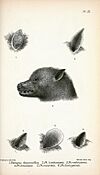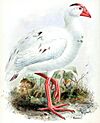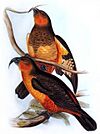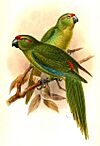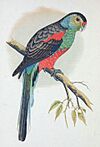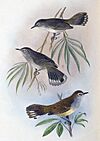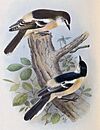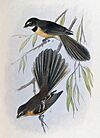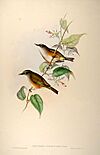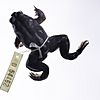List of Australia-New Guinea species extinct in the Holocene facts for kids
The
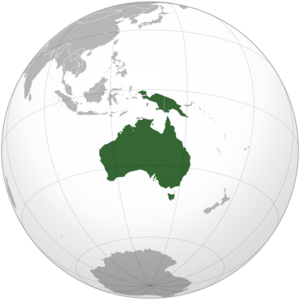
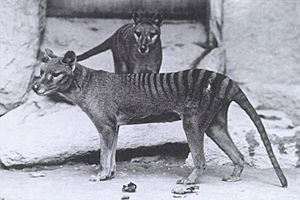
This article is about animals and plants from Australia-New Guinea that have disappeared during the Holocene epoch. The Holocene is a long period of time that started about 11,650 years ago and continues to this day.
The landmass we call Australia-New Guinea is also known as Sahul. It includes mainland Australia, Tasmania, the island of New Guinea, and other nearby islands like the Aru Islands. This huge area is shared by three countries: Australia, Papua New Guinea, and Indonesia.
The animals of Australia-New Guinea are very special. For example, marsupials (like kangaroos and koalas) and monotremes (like echidnas and platypuses) are found here. These unique mammals outcompeted other types of mammals, called placental mammals, which are common on other continents. Only two groups of placental mammals are naturally found here: rodents (like mice) and bats. Other animals like dingoes were brought by humans.
Many species have disappeared from Australia-New Guinea because of human activities. Most of the really big animals, like giant kangaroos, vanished a long time ago. But smaller extinctions have continued, especially after Europeans started settling in Australia in 1788. Some animals, like the thylacine and Tasmanian devil, disappeared from mainland Australia thousands of years before Europeans arrived, but they survived in Tasmania.
Mammals: Animals with Fur
Mammals are warm-blooded animals that usually have fur or hair. They feed their babies milk.
Monotremes: Egg-Laying Mammals
Monotremes are very special mammals because they lay eggs instead of giving birth to live young.
Echidnas: Spiny Anteaters
Echidnas are spiny animals that eat insects.
Western Long-Beaked Echidna: Possibly Gone from Australia
The Western long-beaked echidna (Zaglossus bruijnii) lives in Western New Guinea. Some people think it might have also lived in parts of Western Australia until the early 1900s. Fossils and ancient cave paintings show that a type of long-beaked echidna was in mainland Australia a very long time ago. Scientists are still studying old specimens to find out for sure if this echidna lived in Australia more recently.
| Common name | Scientific name | Range | Comments | Pictures |
|---|---|---|---|---|
| Western long-beaked echidna | Zaglossus bruijnii | Western New Guinea, Indonesia and possibly Kimberley, Western Australia | This critically endangered species lives in Western New Guinea. There's a debate about whether it also lived in mainland Australia more recently. |
Carnivorous Marsupials: Meat Eaters
These marsupials are meat-eaters, just like dogs or cats.
Dog-like Marsupials: The Thylacine
The thylacine was a large marsupial that looked a bit like a dog.
| Common name | Scientific name | Range | Comments | Pictures |
|---|---|---|---|---|
| Thylacine | Thylacinus cynocephalus | Mainland Australia, Tasmania, and New Guinea | The last known thylacine died in a zoo in 1936. Some people think they might have survived in remote parts of Tasmania for a few more decades. Thylacines disappeared from mainland Australia and New Guinea much earlier. Their extinction was likely caused by humans hunting them and competition with dingos. In Tasmania, farmers hunted them to protect their sheep. |
Marsupial Shrews: Small Hunters
These are small, shrew-like marsupials.
Tasmanian Devil: Gone from the Mainland
The Tasmanian devil (Sarcophilus harrisii) used to live across mainland Australia and Tasmania.
| Common name | Scientific name | Range | Comments | Pictures |
|---|---|---|---|---|
| Tasmanian devil | Sarcophilus harrisii | Mainland Australia and Tasmania | Tasmanian devils disappeared from mainland Australia around 1200 BCE. This might have been because of dingoes, human hunting, or climate change. They still live in Tasmania and have even been brought back to parts of New South Wales. |  |
Bandicoots and Bilbies: Diggers and Foragers
Bandicoots and bilbies are marsupials known for their long snouts and strong claws for digging.
Bandicoots: Small, Quick Diggers
| Common name | Scientific name | Range | Comments | Pictures |
|---|---|---|---|---|
| Desert bandicoot | Perameles eremiana | Central Australia | The last known desert bandicoot was seen in 1943. They likely died out because of introduced animals like feral cats and red foxes, and changes to their habitat. | |
| New South Wales barred bandicoot | Perameles fasciata | New South Wales | The last one was collected in 1846. | |
| Southwestern barred bandicoot | Perameles myosuros | Western Australia | The last one was collected in 1906. | |
| Southern barred bandicoot | Perameles notina | South Australia, Victoria, New South Wales | The last one was collected in 1857. | |
| Nullarbor barred bandicoot | Perameles papillon | Nullarbor Plain, southern Australia | The last one was collected in 1928. | |
| Peroryctes aruensis | New Guinea | The most recent remains of this bandicoot are from 9,000 to 28,000 years ago. |
Bilbies: Desert Dwellers
Bilbies are unique marsupials with long ears and tails.
| Common name | Scientific name | Range | Comments | Pictures |
|---|---|---|---|---|
| Lesser bilby | Macrotis leucura | Deserts of Australia | The last lesser bilby was collected in 1931. It probably disappeared because of introduced cats and foxes, and changes to its habitat. |
Pig-Footed Bandicoots: Unusual Feet
These bandicoots had very unusual feet, like tiny hooves.
| Common name | Scientific name | Range | Comments | Pictures |
|---|---|---|---|---|
| Southern pig-footed bandicoot | Chaeropus ecaudatus | Southern and western Australia | The last reliable record was in 1901. Local people said they survived until the 1950s. They likely went extinct because of introduced cats and foxes. | |
| Northern pig-footed bandicoot | Chaeropus yirratji | Central Australia |
Diprotodontia: Kangaroos, Wallabies, and Possums
This group includes many well-known Australian marsupials.
Brushtail Possums and Cuscuses: Tree Dwellers
These marsupials live in trees and have bushy tails.
Telefomin Cuscus: Possibly Gone
| Common name | Scientific name | Range | Comments |
|---|---|---|---|
| Telefomin cuscus | Phalanger matanim | Telefomin and Tifalmin, Papua New Guinea | Last seen in 1997. The area where it lived was destroyed by a fire in 1998. |
Macropods: Hopping Animals
This family includes kangaroos, wallabies, and their relatives.
| Common name | Scientific name | Range | Comments | Pictures |
|---|---|---|---|---|
| Mainland banded hare-wallaby | Lagostrophus fasciatus albipilis | Western Australia | This subspecies is no longer considered valid by some scientists. |  |
| Lake Mackay hare-wallaby | Lagorchestes asomatus | Northern Territory; possibly other deserts | The only known specimen was found in 1932. It likely disappeared between 1940 and 1960 due to introduced cats and foxes, and changes to its habitat. | |
| South-western rufous hare-wallaby | Lagorchestes hirsutus hirsutus | South-west of Western Australia | This subspecies is extinct, but two other subspecies still exist. |  |
| Eastern hare-wallaby | Lagorchestes leporides | Interior southeastern Australia | The last one was collected in 1889. It likely went extinct because its habitat was destroyed by farm animals and increased wildfires. | |
| Toolache wallaby | Notamacropus greyi | Southeastern Australia | The last confirmed sightings were in 1924. The last one in captivity died in 1939. | |
| Crescent nailtail wallaby | Onychogalea lunata | Western and central Australia | The last one was killed in 1956. It went extinct because of introduced cats and foxes, and habitat damage. | |
| Christensen's pademelon | Thylogale christenseni | New Guinea | The most recent remains of this pademelon are from about 1385-1738 BCE. |
Bettongs, Potoroos, and Rat-Kangaroos: Small Hoppers
These are smaller relatives of kangaroos.
| Common name | Scientific name | Range | Comments | Pictures |
|---|---|---|---|---|
| Desert bettong | Bettongia anhydra | Tanami Desert and Nullarbor Plain | Only known from one specimen found in 1933. It likely went extinct because of introduced cats and foxes, and changes to its habitat. | |
| South-eastern woylie | Bettongia penicillata penicillata | South-eastern Australia | This subspecies is extinct. The woylie's population greatly decreased due to habitat loss and introduced cats and foxes. |  |
| Nullarbor dwarf bettong | Bettongia pusilla | Nullarbor Plain, Hampton and Mallee regions | Known only from old remains, but thought to have lived until European settlement. | |
| Desert rat-kangaroo | Caloprymnus campestris | Channel Country and possibly southeastern Queensland | The last confirmed sighting was in 1935. It is believed to have gone extinct because of introduced cats and foxes. | |
| Broad-faced potoroo | Potorous platyops | From the Swan Coastal Plain to the Eyre and Yorke Peninsulas, and Kangaroo Island | Last seen in 1875. It likely went extinct because of introduced cats, diseases, wildfires, and habitat loss from grazing animals. |
Rodents: Rats and Mice
This group includes many types of rats and mice.
Old World Rats and Mice: Native Rodents
| Common name | Scientific name | Range | Comments | Pictures |
|---|---|---|---|---|
| White-footed rabbit rat | Conilurus albipes | South-eastern South Australia, Victoria, New South Wales and eastern Queensland | Last recorded around 1860. It probably disappeared due to introduced cats and habitat damage. |  |
| Capricorn rabbit rat | Conilurus capricornensis | Queensland | Known only from old remains. It is thought to have lived until European settlement. | |
| Lesser stick-nest rat | Leporillus apicalis | Arid and semiarid central Australia | The last specimens were collected in 1933. It likely went extinct because of introduced cats and habitat damage. |  |
| Bramble Cay melomys | Melomys rubicola | Bramble Cay, Queensland | Last recorded in 2009. It disappeared because of increasing storms that destroyed its island home. This was the first mammal extinction directly linked to climate change. | |
| Short-tailed hopping mouse | Notomys amplus | From north-eastern South Australia and south-eastern Northern Territory to North West Cape | Only known from specimens collected in 1896. The reasons for its extinction are unknown, but introduced cats and foxes might be to blame. | |
| Long-tailed hopping-mouse | Notomys longicaudatus | From north-western New South Wales to North West Cape | Last collected in 1901-1902. Its extinction is blamed on introduced cats. | |
| Big-eared hopping-mouse | Notomys macrotis | Western central wheatbelt of Western Australia | Last collected in 1843. It likely went extinct because of diseases or introduced cats, with habitat damage from sheep also playing a part. | |
| Darling Downs hopping mouse | Notomys mordax | Darling Downs, Queensland | Known from only one skull found in 1846. It is believed to be extinct because of introduced cats and habitat destruction from farming. | |
| Great hopping mouse | Notomys robustus | Davenport and Flinders Ranges, South Australia | Only known from skulls found in old owl nests. | |
| Blue-gray mouse | Pseudomys glaucus | South-eastern Queensland and north-eastern New South Wales | Last collected before 1892. Its extinction is believed to be due to habitat loss and introduced cats and foxes. | |
| Maclear's rat | Rattus macleari | Christmas Island | Last collected in 1901-1902. It died out after getting sick from a parasite carried by fleas from introduced black rats. | |
| Bulldog rat | Rattus nativitatis | Christmas Island | Last recorded in 1897-1898. It also died out from the same disease as Maclear's rat. |
Emma's Giant Rat: Possibly Gone
| Common name | Scientific name | Range | Comments |
|---|---|---|---|
| Emma's giant rat | Uromys emmae | Owi Island, Papua, Indonesia | Last seen in 1946. |
Bats: Flying Mammals
Bats are the only mammals that can truly fly.
Megabats: Fruit Bats
These bats are often called fruit bats or flying foxes.
| Common name | Scientific name | Range | Comments | Pictures |
|---|---|---|---|---|
| Percy Island flying fox | Pteropus brunneus | Percy Islands, Queensland | Known from only one specimen collected in 1874. It might have disappeared because of habitat loss. |
Aru Flying Fox: Possibly Gone
| Common name | Scientific name | Range | Comments | Pictures |
|---|---|---|---|---|
| Aru flying fox | Pteropus aruensis | Aru Islands, Indonesia | Described in the mid-1800s. No sightings in the 1900s, but a jawbone found in 1992 might belong to this species. |  |
Vesper Bats: Common Bats
These are the most common type of bats.
| Common name | Scientific name | Range | Comments |
|---|---|---|---|
| Christmas Island pipistrelle | Pipistrellus murrayi | Christmas Island | Last recorded in 2009. Its population dropped by 90% in just 10-15 years. The reasons are not clear, but introduced animals and diseases might be factors. |
| Lord Howe long-eared bat | Nyctophilus howensis | Lord Howe Island, New South Wales | Known from only one skull found in 1972. It might have been hunted by introduced rats and owls. |
Birds: Feathered Friends
Birds are animals with feathers, wings, and beaks.
Cassowaries and Emus: Large Flightless Birds
These are large birds that cannot fly.
| Common name | Scientific name | Range | Comments | Pictures |
|---|---|---|---|---|
| Kangaroo Island emu | Dromaius novaehollandiae baudinianus | Kangaroo Island | Last recorded in 1819. It was hunted until it disappeared. |  |
| King Island emu | Dromaius novaehollandiae minor | King Island, Tasmania | Last seen in the wild in 1805. The last one in captivity died in 1822. It was hunted until it disappeared. |  |
| Tasmanian emu | Dromaius novaehollandiae diemenensis | Tasmania | Last recorded in 1851. It was hunted until it disappeared. |  |
Pigeons and Doves: Common Birds
These birds are known for their cooing sounds.
| Common name | Scientific name | Range | Comments | Pictures |
|---|---|---|---|---|
| Lord Howe pigeon | Columba vitiensis godmanae | Lord Howe Island | Hunted until it disappeared in 1853. | 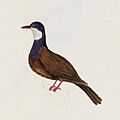 |
| Norfolk pigeon | Hemiphaga novaeseelandiae spadicea | Norfolk Island | Last recorded in 1900. It was hunted until it disappeared. | 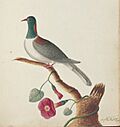 |
| Norfolk ground dove | Pampusana norfolkensis | Norfolk and possibly Nepean Island | Known from old paintings and descriptions. It disappeared a long time ago. |
Rails and Cranes: Water Birds
Rails are often shy, ground-dwelling birds.
| Common name | Scientific name | Range | Comments | Pictures |
|---|---|---|---|---|
| Macquarie Island banded rail | Hypotaenidia philippensis macquarensis | South Macquarie Island, Tasmania | Last recorded in 1879. It disappeared because of hunting and introduced animals like cats and dogs. | |
| Norfolk Island rail | Hypotaenidia sp. | Norfolk Island | It was hunted until it disappeared. | |
| Western Lewin's rail | Lewinia pectoralis clelandi | Southwestern Australia | Last recorded in 1932. It went extinct because its wetland habitat was drained and burned for farms. | |
| White swamphen | Porphyrio albus | Lord Howe Island, New South Wales | Last recorded in 1790. It was hunted by sailors and was gone by the time the island was settled in 1834. | |
| Norfolk swamphen | Porphyrio sp. | Norfolk Island | This bird was extinct before Europeans arrived in 1788. |
Tasmanian Nativehen: Gone from the Mainland
| Common name | Scientific name | Range | Comments | Pictures |
|---|---|---|---|---|
| Tasmanian nativehen | Tribonyx mortierii | Mainland Australia and Tasmania | This bird cannot fly and is common in Tasmania today. It used to live on mainland Australia but disappeared about 4,700 years ago. This might have been due to human hunting, the introduction of the dingo, or a very dry climate. |
Owls: Night Hunters
Owls are birds of prey that hunt at night.
True Owls: Common Owls
| Common name | Scientific name | Range | Comments | Images |
|---|---|---|---|---|
| Lord Howe boobook | Ninox novaeseelandiae albaria | Lord Howe Island, New South Wales | Probably disappeared in the 1940s or 1950s. This was due to trees being cut down and introduced black rats. | 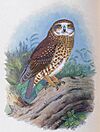 |
| Norfolk boobook | Ninox novaeseelandiae undulata | Norfolk Island | The last individual died in 1996. It declined because of habitat loss and competition with other birds. | 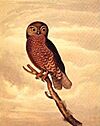 |
Parrots: Colorful Birds
Parrots are known for their bright colors and ability to mimic sounds.
Kea and Kākā: New Zealand Parrots
| Common name | Scientific name | Range | Comments | Pictures |
|---|---|---|---|---|
| Norfolk kākā | Nestor productus | Norfolk Island | The last birds in the wild were seen between 1825 and 1854. The last one in captivity died in 1851. They disappeared because of hunting and habitat destruction by introduced animals like rabbits and pigs. |
Old World Parrots: Diverse Parrots
| Common name | Scientific name | Range | Comments | Pictures |
|---|---|---|---|---|
| Lord Howe parakeet | Cyanoramphus subflavescens | Lord Howe Island, New South Wales | Last seen in 1869. Farmers killed them because they ate garden plants and crops. | |
| Macquarie parakeet | Cyanoramphus novaezelandiae erythrotis | Macquarie Island, Tasmania | Last seen in 1890. It probably went extinct because of introduced weka birds and rabbits. | |
| Paradise parrot | Psephotellus pulcherrimus | Southeastern Queensland and possibly New South Wales | Last confirmed sighting in 1927 or 1928. It disappeared due to droughts, overgrazing by farm animals, habitat loss, and hunting. |
Perching Birds: Songbirds and More
This is a very large group of birds, often called songbirds.
Australasian Wrens: Small, Active Birds
| Common name | Scientific name | Range | Comments | Pictures |
|---|---|---|---|---|
| Dirk Hartog thick-billed grasswren | Amytornis textilis carteri | Dirk Hartog Island, Western Australia | Last recorded in 1918. It disappeared because of introduced black rats. | |
| Namoi Valley thick-billed grasswren | Amytornis textilis inexpectatus | Central New South Wales | Last recorded in 1912. The reasons for its extinction are unknown. | |
| Southwestern thick-billed grasswren | Amytornis textilis macrourus | Southwestern Australia | Last recorded in 1910. It went extinct due to drought and overgrazing by introduced mammals. |
Bristlebirds: Secretive Birds
| Common name | Scientific name | Range | Comments | Pictures |
|---|---|---|---|---|
| Western rufous bristlebird | Dasyornis broadbenti litoralis | Southwestern Australia | Last recorded around 1930. It disappeared because its habitat was burned for farms and due to introduced cats. |
Australian Warblers: Small Insect Eaters
| Common name | Scientific name | Range | Comments | Pictures |
|---|---|---|---|---|
| Lord Howe gerygone | Gerygone insularis | Lord Howe Island, New South Wales | Last recorded in 1928. It likely went extinct because introduced black rats raided its nests. |
Cuckooshrikes and Allies: Varied Birds
| Common name | Scientific name | Range | Comments | Pictures |
|---|---|---|---|---|
| Norfolk triller | Lalage leucopyga leucopyga | Norfolk Island | Last recorded in 1942. It probably went extinct because of introduced black rats and trees being cut down. |
Fantails and Silktails: Agile Birds
| Common name | Scientific name | Range | Comments | Pictures |
|---|---|---|---|---|
| Lord Howe fantail | Rhipidura fuliginosa cervina | Lord Howe Island, New South Wales | Last recorded in 1924. It probably disappeared because of introduced black rats. |
White-eyes: Small, Social Birds
| Common name | Scientific name | Range | Comments | Pictures |
|---|---|---|---|---|
| Robust white-eye | Zosterops strenuus | Lord Howe Island, New South Wales | It is believed to have gone extinct because of black rats that arrived on the island in 1918. |
White-Chested White-Eye: Possibly Gone
| Common name | Scientific name | Range | Comments | Pictures |
|---|---|---|---|---|
| White-chested white-eye | Zosterops albogularis | Norfolk Island | Last confirmed sighting in 2000. This species declined because of competition with another introduced bird, black rats, and habitat loss. |
Thrushes: Ground Foragers
| Common name | Scientific name | Range | Comments | Pictures |
|---|---|---|---|---|
| Norfolk thrush | Turdus poliocephalus poliocephalus | Norfolk Island | This subspecies went extinct around the late 1970s. It was due to habitat loss and introduced rats and cats. | |
| Lord Howe thrush | Turdus poliocephalus vinitinctus | Lord Howe Island, New South Wales | Not recorded since about 1924. It is believed to have gone extinct because of introduced black rats. |
Starlings: Social Birds
| Common name | Scientific name | Range | Comments | Pictures |
|---|---|---|---|---|
| Norfolk Island starling | Aplonis fusca fusca | Norfolk Island | Last recorded in 1923. It may have disappeared due to habitat destruction or introduced black rats. | |
| Lord Howe starling | Aplonis fusca hulliana | Lord Howe Island, New South Wales | Last seen in 1918. It probably disappeared because of black rats introduced to the island that year. |
Reptiles: Scaly Creatures
Reptiles are cold-blooded animals with scales.
Squamates: Lizards and Snakes
This group includes lizards and snakes.
Common Geckos: Night Lizards
Christmas Island Chained Gecko: Gone from the Wild
| Common name | Scientific name | Range | Comments |
|---|---|---|---|
| Christmas Island chained gecko | Lepidodactylus listeri | Christmas Island | Last recorded in the wild in 2012. It likely disappeared because of introduced Indian wolf snakes. |
Skinks: Smooth-Scaled Lizards
| Common name | Scientific name | Range | Comments |
|---|---|---|---|
| Christmas Island forest skink | Emoia nativitatis | Christmas Island | Last seen in the wild in 2010. It went extinct because of introduced Indian wolf snakes, possibly made worse by trees being cut down. |
Christmas Island Blue-Tailed Skink: Gone from the Wild
| Common name | Scientific name | Range | Comments |
|---|---|---|---|
| Christmas Island blue-tailed skink | Cryptoblepharus egeriae | Christmas Island | Last seen in the wild in 2010. It likely disappeared because of introduced Indian wolf snakes. |
Amphibians: Frogs and Toads
Amphibians are animals that can live both on land and in water.
Frogs: Jumping Amphibians
Australian Ground Frogs: Unique Frogs
| Common name | Scientific name | Range | Comments | Pictures |
|---|---|---|---|---|
| Southern gastric-brooding frog | Rheobatrachus silus | Conondale and Blackall Ranges, Queensland | Last seen in the wild in 1981. The last one in captivity died in 1983. The reasons for its extinction are unknown, but a frog disease called chytridiomycosis is suspected. | |
| Northern gastric-brooding frog | Rheobatrachus vitellinus | Eungella National Park, Queensland | Last recorded in 1985. Chytridiomycosis is suspected as the cause of its extinction. | |
| Sharp snouted day frog | Taudactylus acutirostris | Coastal north Queensland from Mount Graham to the Big Tableland | Last seen in 1997. It was apparently wiped out by chytridiomycosis. | |
| Mount Glorious day frog | Taudactylus diurnus | Blackall, Conondale, and D'Aguilar Ranges in southeast Queensland | Last recorded in 1979. Chytridiomycosis is suspected as the cause of its extinction. |
Treefrogs and Allies: Climbing Frogs
| Common name | Scientific name | Range | Comments |
|---|---|---|---|
| Mountain mist frog | Ranoidea nyakalensis | Wet Tropics of Queensland | Last recorded in 1990. It rapidly declined, likely due to chytridiomycosis. |
Ray-Finned Fish: Fish with Bony Fins
This group includes most of the fish we know.
Anglerfish: Unique Fish
Handfish: Fish That Walk
Handfish are unique fish that use their fins to "walk" on the seabed.
Smooth Handfish: Data Deficient
| Common name | Scientific name | Range | Comments |
|---|---|---|---|
| Smooth handfish | Sympterichthys unipennis | Southeastern Tasmania | Last recorded in 1802. It might have disappeared because its habitat was destroyed and it was accidentally caught in fishing nets. |
Galaxias: Small Freshwater Fish
Galaxias: Freshwater Fish
Pedder Galaxias: Gone from the Wild
| Common name | Scientific name | Range | Comments | Pictures |
|---|---|---|---|---|
| Pedder galaxias | Galaxias pedderensis | Lake Pedder, Tasmania | This fish disappeared from its original home, Lake Pedder, after the area was flooded for power generation. Introduced trout also played a big role in its decline. The last wild one was caught in 1996. Luckily, this species still lives in two other places where it was moved for safety. |  |
Insects: Tiny Creatures
Insects are small invertebrates with six legs.
Beetles: Hard-Shelled Insects
Predaceous Diving Beetles: Water Hunters
| Scientific name | Range |
|---|---|
| Rhantus papuanus | Papua New Guinea |
Snails and Slugs: Slimy Creatures
These are soft-bodied animals that often have shells.
Lord Howe Flax Snail: A Land Snail
| Common name | Scientific name | Range | Comments |
|---|---|---|---|
| Lord Howe flax snail (subspecies) | Placostylus bivaricosus etheridgei | Lord Howe Island, New South Wales | This is a type of land snail. |
Plants: Green Life
Plants are living things that make their own food using sunlight.
Plants Listed as Extinct by the Australian Government
The Australian government has a list of plants that are considered extinct since European settlement began in 1788. There are 37 plant species on this list. Sometimes, plants thought to be extinct are rediscovered, like Pimelea spinescens subsp. pubiflora in 2005.
| Name | Common name | Distribution |
|---|---|---|
| Acacia kingiana | WA | |
| Acacia prismifolia | Diel's wattle | WA |
| Acianthus ledwardii | QLD | |
| Amperea xiphoclada var. pedicellata | NSW | |
| Amphibromus whitei | QLD | |
| Caladenia brachyscapa | short spider-orchid | TAS |
| Coleanthera virgata | hidden coleanthera | WA |
| Deyeuxia lawrencei | TAS | |
| Didymoglossum exiguum | QLD | |
| Diuris bracteata | NSW | |
| Euphrasia ruptura | NSW | |
| Frankenia decurrens | decurrent-leaved frankenia | WA |
| Huperzia serrata | water tassel-fern | QLD |
| Hymenophyllum lobbii | QLD | |
| Hymenophyllum whitei | QLD | |
| Lemmaphyllum accedens | QLD | |
| Lepidium drummondii | Drummond's lepidium | WA |
| Leucopogon cryptanthus | small-flowered leucopogon | WA |
| Lycopodium volubile = Pseudodiphasium volubile | QLD | |
| Marsdenia araujacea | QLD | |
| Monogramma dareicarpa | grass fern | QLD |
| Musa fitzalanii | Daintree banana | QLD |
| Myriocephalus nudus | WA | |
| Olearia oliganthema | NSW | |
| Opercularia acolytantha | WA | |
| Ozothamnus selaginoides | clubmoss everlasting, Table Mountain daisy bush | TAS |
| Paspalum batianoffii | QLD | |
| Persoonia laxa | NSW | |
| Persoonia prostrata | QLD | |
| Pultenaea maidenii | Maiden's bush-pea | VIC |
| Senecio georgianus | grey groundsel | NSW, SA, VIC |
| Solanum bauerianum | bridal flower | LHI, NI |
| Tetratheca fasciculata | Cronin's tetratheca | WA |
| Thomasia gardneri | Mount Holland thomasia | WA |
| Tmesipteris lanceolata | QLD | |
| Trianthema cypseleoides | NSW | |
| Vanvoorstia bennettiana | Bennett's seaweed | NSW |
Plants Listed as Extinct by States and Territories

Each state and territory in Australia also keeps its own lists of extinct plants and animals. These lists might be different from the federal government's list.
Tasmania: Plants Declared Extinct
Tasmania has 20 plant species listed as "presumed extinct."
- Ballantinia antipoda
- Banksia integrifolia subsp. integrifolia
- Botrychium australe
- Caladenia cardiochila
- Chenopodium erosum
- Coopernookia barbata
- Hibbertia obtusifolia
- Lepilaena australis
- Levenhookia dubia
- Myriophyllum glomeratum
- Podotheca angustifolia
- Prostanthera cuneata
- Punctelia subflava
- Senecio macrocarpus
- Thesium australe
- Thynninorchis huntiana
- Veronica notabilis
Images for kids


















